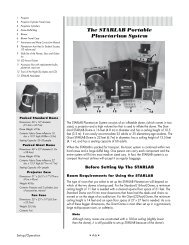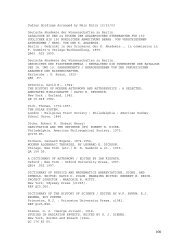K-6 Activities - Dudley Observatory
K-6 Activities - Dudley Observatory
K-6 Activities - Dudley Observatory
You also want an ePaper? Increase the reach of your titles
YUMPU automatically turns print PDFs into web optimized ePapers that Google loves.
Grade Two<br />
Grade Three<br />
K–6 <strong>Activities</strong> • B–8 •<br />
Grade Two<br />
1. In STARLAB, using the Greek Mythology Cylinder, review the constellations<br />
introduced in Grade One section but add the stories of Leo the Lion, Auriga the<br />
Charioteer, Lepus the Hare, Draco, and the Pleiades. Look at these constellations<br />
using the Constellation Cylinder. Hand out arrow pointers and show their<br />
locations. Look at the Starfield Cylinder and try to locate the same constellations.<br />
After leaving STARLAB, hand out star maps, and show the proper way to use<br />
them discussing the cardinal directions.<br />
2. In STARLAB, use the Earth Cylinder to discuss the global continents. Introduce the<br />
concept of longitude by tying it in with time zones (each is 15° of longitude wide<br />
on average). Introduce latitude and determine your location’s latitude. Use the<br />
Celestial Coordinates Cylinder and tie in latitude and longitude with declination<br />
and right ascension. Introduce the celestial equator. Show the moon phases on<br />
the Starfield Cylinder.<br />
3. In STARLAB, show the Aurora Borealis slides. Using colored chalk and a piece of<br />
black construction paper, have students draw what they think the Northern Lights<br />
look like. If time allows, show the Native American Mythology Cylinder and<br />
review and introduce new stories.<br />
4. In the classroom, make aluminum foil constellations using current star maps. Do<br />
the “Circle Puzzle” (PASS Volume 5, Constellations Tonight) to recognize that the<br />
constellations which they invent can be just as useful as the ancient Greek and<br />
Roman constellations. Do the “Dots Puzzle” (also PASS Volume 5).<br />
Grade Three<br />
1. In STARLAB, review all of the above winter constellations using the Greek Mythology<br />
Cylinder. Introduce the spring constellations of Bootes, Virgo, and Hydra.<br />
Run back to back winter and spring star maps. Using star maps, work in groups<br />
of four to identify the constellations on the Constellation Cylinder. Put the Starfield<br />
Cylinder on and try to locate the winter and spring constellations in the night sky.<br />
2. Do the “Red Planet Mars” lesson (PASS Volume 6) in STARLAB in which children<br />
find a “star” much like Mars. See slides of Lowell’s study of Mars, and using<br />
Exobiology, create a creature that could live on Mars with its conditions of thin<br />
atmosphere, cold temperatures, and low gravity.<br />
3. In STARLAB, review the Native American Mythology Cylinder and legends about<br />
Native American constellations. Add the legend of the lizard, snake and butterfly.<br />
Show the Earth Cylinder. Find the continents and continue the discussion<br />
of latitude and longitude and how they relate to the celestial equator. View the<br />
African Mythology Cylinder and tell stories from various groups from Africa.<br />
4. In the classroom, make constellation viewers using film containers (page 21).<br />
Make “Star Clocks” (page 12).





